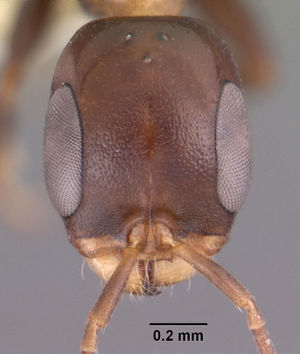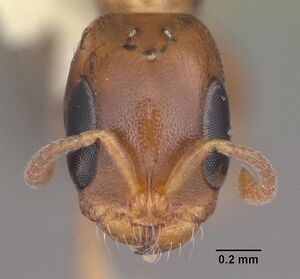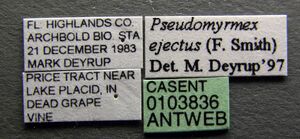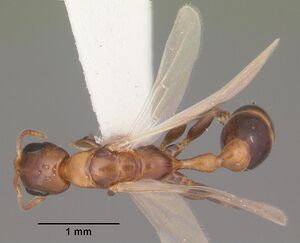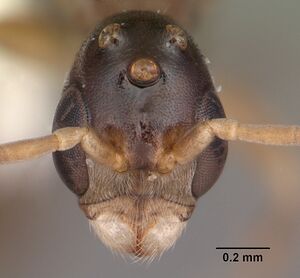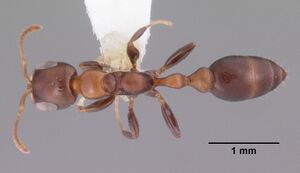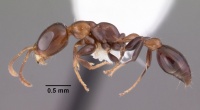AntWiki: The Ants --- Online
Gillette et al. (2015), in a Chaipas, Mexico field study of twig-nesting ants in coffee plants, found P. ejectus occupied 57% of all occupied twig-nests above 1100 m. In Florida, this species is the host for the workerless parasite Pseudomyrmex leptosus.
Identification
Keys including this Species
Distribution
Latitudinal Distribution Pattern
Latitudinal Range: 34.62849° to 8.7°.
Nearctic Region: United States.
Neotropical Region: Bolivia, Brazil, Costa Rica, Greater Antilles, Guatemala, Mexico.
Distribution based on AntMaps
Distribution based on AntWeb specimens
Check data from AntWeb
Countries Occupied
| Number of countries occupied by this species based on AntWiki Regional Taxon Lists. In general, fewer countries occupied indicates a narrower range, while more countries indicates a more widespread species.
|

|
Estimated Abundance
| Relative abundance based on number of AntMaps records per species (this species within the purple bar). Fewer records (to the left) indicates a less abundant/encountered species while more records (to the right) indicates more abundant/encountered species.
|

|
Biology
Association with Other Organisms
 Explore: Show all Associate data or Search these data. See also a list of all data tables or learn how data is managed.
Explore: Show all Associate data or Search these data. See also a list of all data tables or learn how data is managed.
- This species is a prey for the syrphid fly Rhopalosyrphus ramulorum (a predator) (Quevillon, 2018).
|
|
|
|
|
X
|
X
|
X
|
|
|
|
|
|
| Jan
|
Feb
|
Mar
|
Apr
|
May
|
Jun
|
Jul
|
Aug
|
Sep
|
Oct
|
Nov
|
Dec
|
Source: antkeeping.info.
 Explore: Show all Flight Month data or Search these data. See also a list of all data tables or learn how data is managed.
Explore: Show all Flight Month data or Search these data. See also a list of all data tables or learn how data is managed.
Castes
Queen
Male
Nomenclature
The following information is derived from Barry Bolton's Online Catalogue of the Ants of the World.
- ejectus. Pseudomyrma ejecta Smith, F. 1858b: 157 (w.) "probably Brazil". Emery, 1894c: 147 (q.). Combination in Pseudomyrmex: Kempf, 1972a: 217. Senior synonym of lincecumii: Ward, 1989: 436. See also: Ward, 1985b: 232.
- lincecumii. Ponera (Ectatomma) lincecumii Buckley, 1866: 172 (w.) U.S.A. Combination in Pseudomyrma: Mayr, 1886d: 464; in Leptalea: Smith, M.R. 1951a: 788. See also: Emery, 1895c: 270. Junior synonym of ejectus: Ward, 1989: 436.
Description
References
- Alatorre-Bracamontes, C.E., Vásquez-Bolaños, M. 2010. Lista comentada de las hormigas (Hymenoptera: Formicidae) del norte de México. Dugesiana 17(1): 9-36.
- Baena, M.L., Escobar, F., Valenzuela, J.E. 2019. Diversity snapshot of green–gray space ants in two Mexican cities. International Journal of Tropical Insect Science 40, 239–250 (doi:10.1007/s42690-019-00073-y).
- Davis, T. 2009. The ants of South Carolina (thesis, Clemson University).
- Deyrup, M.A., Carlin, N., Trager, J., Umphrey, G. 1988. A review of the ants of the Florida Keys. Florida Entomologist 71: 163-176.
- Emery, C. 1894d. Studi sulle formiche della fauna neotropica. VI-XVI. Bull. Soc. Entomol. Ital. 26: 137-241 (page 147, queen described)
- Gillette, P. N., K. K. Ennis, G. D. Martinez, and S. M. Philpott. 2015. Changes in Species Richness, Abundance, and Composition of Arboreal Twig-nesting Ants Along an Elevational Gradient in Coffee Landscapes. Biotropica. 47:712-722. doi:10.1111/btp.12263
- Gochnour, B.M., Suiter, D.R., Booher, D. 2019. Ant (Hymenoptera: Formicidae) fauna of the Marine Port of Savannah, Garden City, Georgia (USA). Journal of Entomological Science 54, 417-429 (doi:10.18474/jes18-132).
- Hill, J.G. 2015. Ants (Hymenoptera: Formicidae) of the Big Thicket Region of Texas. Midsouth Entomologist 8: 24-34.
- Ipser, R.M., Brinkman, M.A., Gardner, W.A., Peeler, H.B. 2004. A survey of ground-dwelling ants (Hymenoptera: Formicidae) in Georgia. Florida Entomologist 87: 253-260.
- Kempf, W. W. 1972b. Catálogo abreviado das formigas da regia~o Neotropical. Stud. Entomol. 15: 3-344 (page 217, Combination in Pseudomyrmex)
- Moura, M.N., Cardoso, D.C., Cristiano, M.P. 2020. The tight genome size of ants: diversity and evolution under ancestral state reconstruction and base composition. Zoological Journal of the Linnean Society, zlaa135 (doi:10.1093/zoolinnean/zlaa135).
- Smith, F. 1858b. Catalogue of hymenopterous insects in the collection of the British Museum. Part VI. Formicidae. London: British Museum, 216 pp. (page 157, worker described)
- Varela-Hernández, F., Medel-Zosayas, B., Martínez-Luque, E.O., Jones, R.W., De la Mora, A. 2020. Biodiversity in central Mexico: Assessment of ants in a convergent region. Southwestern Entomologist 454: 673-686.
- Ward, P. S. 1985b. The Nearctic species of the genus Pseudomyrmex (Hymenoptera: Formicidae). Quaest. Entomol. 21: 209-246 (page 232, see also)
- Ward, P. S. 1989a. Systematic studies on pseudomyrmecine ants: revision of the Pseudomyrmex oculatus and P. subtilissimus species groups, with taxonomic comments on other species. Quaest. Entomol. 25: 393-468 (page 436, Senior synonym of lincecumii)
- Adams B. J., S. A. Schnitzer, and S. P. Yanoviak. 2016. Trees as islands: canopy ant species richness increases with the size of liana-free trees in a Neotropical forest. Ecography doi: 10.1111/ecog.02608
- Adams B. J., S. A. Schnitzer, and S. P. Yanoviak. 2019. Connectivity explains local ant community structure in a Neotropical forest canopy: a large-scale experimental approach. Ecology 100(6): e02673.
- Addison D. S., I. Bartoszek, V. Booher, M. A. Deyrup, M. Schuman, J. Schmid, and K. Worley. 2016. Baseline surveys for ants (Hymenoptera: Formicidae) of the western Everglades, Collier County, Florida. Florida Entomologist 99(3): 389-394.
- Alatorre-Bracamontes, C.E. and M Vasquez-Bolanos. 2010. Lista comentada de las hormigas (Hymenoptera: Formicidae) del norte de México. Dugesiana 17(1):9-36
- Annotated Ant Species List Ordway-Swisher Biological Station. Downloaded at http://ordway-swisher.ufl.edu/species/os-hymenoptera.htm on 5th Oct 2010.
- Brandao, C.R.F. 1991. Adendos ao catalogo abreviado das formigas da regiao neotropical (Hymenoptera: Formicidae). Rev. Bras. Entomol. 35: 319-412.
- Colby, D. and D. Prowell. 2006. Ants (Hymenoptera: Formicidae) in Wet Longleaf Pine Savannas in Louisiana. Florida Entomologist 89(2):266-269
- Dash S. T. and L. M. Hooper-Bui. 2008. Species diversity of ants (Hymenoptera: Formicidae) in Louisiana. Conservation Biology and Biodiversity. 101: 1056-1066
- Dattilo W. et al. 2019. MEXICO ANTS: incidence and abundance along the Nearctic-Neotropical interface. Ecology https://doi.org/10.1002/ecy.2944
- De la Mora, A., C. J. Murnen, and S. M. Philpott. 2013. Local and landscape drivers of biodiversity of four groups of ants in Neotropical coffee landscapes. Biodiversity and Conservation 22: 871-888.
- Del Toro, I., M. Vázquez, W.P. Mackay, P. Rojas and R. Zapata-Mata. Hormigas (Hymenoptera: Formicidae) de Tabasco: explorando la diversidad de la mirmecofauna en las selvas tropicales de baja altitud. Dugesiana 16(1):1-14.
- Deyrup M., C. Johnson, G. C. Wheeler, J. Wheeler. 1989. A preliminary list of the ants of Florida. Florida Entomologist 72: 91-101
- Deyrup, M. and J. Trager. 1986. Ants of the Archbold Biological Station, Highlands County, Florida (Hymenoptera: Formicidae). Florida Entomologist 69(1):206-228
- Deyrup, Mark A., Carlin, Norman, Trager, James and Umphrey, Gary. 1988. A Review of the Ants of the Florida Keys. The Florida Entomologist. 71(2):163-176.
- Emery C. 1894. Studi sulle formiche della fauna neotropica. VI-XVI. Bullettino della Società Entomologica Italiana 26: 137-241.
- Fernández, F. and S. Sendoya. 2004. Lista de las hormigas neotropicales. Biota Colombiana Volume 5, Number 1.
- Forster J.A. 2005. The Ants (hymenoptera: Formicidae) of Alabama. Master of Science, Auburn University. 242 pages.
- General D.M. & Thompson L.C. 2008. New Distributional Records of Ants in Arkansas for 2008. Journal of the Arkansas Academy of Science. 63: 182-184
- Gonthier, D. J., K. K. Ennis, S. M. Philpott, J. Vandermeer, and I. Perfecto. 2013. Ants defend coffee from berry borer colonization. BioControl 58: 815-820.
- Gove, A. D., J. D. Majer, and V. Rico-Gray. 2009. Ant assemblages in isolated trees are more sensitive to species loss and replacement than their woodland counterparts. Basic and Applied Ecology 10: 187-195.
- INBio Collection (via Gbif)
- Ipser R. M. 2004. Native and exotic ants (Hymenoptera: Formicidae) of Georgia: Ecological Relationships with implications for development of biologically-based management strategies. Doctor of Philosophy thesis, University of Georgia. 165 pages.
- Johnson C. 1986. A north Florida ant fauna (Hymenoptera: Formicidae). Insecta Mundi 1: 243-246
- Kempf, W.W. 1972. Catalago abreviado das formigas da regiao Neotropical (Hym. Formicidae) Studia Entomologica 15(1-4).
- Larsen, A., and S. M. Philpott. 2010. Twig-nesting ants: the hidden predators of the coffee berry borer in Chiapas, Mexico. Biotropica 42: 342-347.
- Livingston G. F., S. M. Philpott, and A. de la Mora Rodriguez. 2012. Do species sorting and mass effects drive assembly in tropical agroecological landscape mosaics? Biotropica 45(1): 10-17.
- Longino J. et al. ADMAC project. Accessed on March 24th 2017 at https://sites.google.com/site/admacsite/
- MacGown J. A., J. G. Hill, R. L. Brown, T. L. Schiefer, J. G. Lewis. 2012. Ant diversity at Noxubee National Wildlife Refuge in Oktibbeha, Noxubee, and Winston Counties, Mississippi. Mississippi Agricultural and Forestry Experiment Station Bulletin 1197: 1-30
- MacGown J. A., J. G. Hill, and R. L. Brown. 2010. Native and exotic ant in Mississippi state parks. Proceedings: Imported Fire Ant Conference, Charleston, South Carolina, March 24-26, 2008: 74-80.
- MacGown, J. 2011. Ants of South Carolina (species list).
- MacGown, J.A and J.A. Forster. 2005. A preliminary list of the ants (Hymenoptera: Formicidae) of Alabama, U.S.A. Entomological News 116(2):61-74
- MacGown, J.A., J.G. Hill, R.L. Brown and T.L. 2009. Ant Diversity at Noxubee National Wildlife Refuge in Oktibbeha, Noxubee, and Winston Counties, Mississippi Report #2009-01. Schiefer. 2009.
- Mathis, K. A., S. M. Philpott, and S. R. Ramirez. 2016. Variation in spatial scale of competing polydomous twig-nesting ants in coffee agroecosystems. Insectes Sociaux 63: 447-456.
- McDonald D. L., D. R. Hoffpauir, and J. L. Cook. 2016. Survey yields seven new Texas county records and documents further spread of Red Imported Fire Ant, Solenopsis invicta Buren. Southwestern Entomologist, 41(4): 913-920.
- Moreau C. S., M. A. Deyrup, and L. R. David Jr. 2014. Ants of the Florida Keys: Species Accounts, Biogeography, and Conservation (Hymenoptera: Formicidae). J. Insect Sci. 14(295): DOI: 10.1093/jisesa/ieu157
- O'Keefe S. T., J. L. Cook, T. Dudek, D. F. Wunneburger, M. D. Guzman, R. N. Coulson, and S. B. Vinson. 2000. The Distribution of Texas Ants. The Southwestern Entomologist 22: 1-92.
- Parys K. A., M. L. Gimmel, and S. J. Johnson. 2013. Checklist of Insects Associated with Salvinia minima Baker in Louisiana, USA. Check List 9(6): 14881495.
- Philpott, S.M. and P.F. Foster. 2005. Nest-site limitation in coffee agroecosytems: Artificial nests maintain diversity of arboreal ants. Ecological Applications 15(4):1478-1485
- Philpott, S.M., P. Bichier, R. Rice, and R. Greenberg. 2007. Field testing ecological and economic benefits of coffee certification programs. Conservation Biology 21: 975-985.
- Rico-Gray, V. 1993. Use of plant-derived food resources by ants in the dry tropical lowlands of coastal Veracruz, Mexico. Biotropica 25(3):301-315.
- Rico-Gray,V., J.G. Garcia-Franco, M. Palacios-Rios, C. Diaz-Castelazo, V. Parra-Tabla and J.A. Navarro. 1998. Geographical and Seasonal Variation in the Richness of Ant-Plant Interactions in Mexico. Biotropica 30(2):190-200.
- Vásquez-Bolaños M. 2011. Lista de especies de hormigas (Hymenoptera: Formicidae) para México. Dugesiana 18: 95-133
- Ward P. S. 1985. The Nearctic species of the genus Pseudomyrmex (Hymenoptera: Formicidae). Quaestiones Entomologicae 21: 209-246
- Ward P. S. 1992. Ants of the genus Pseudomyrmex (Hymenoptera: Formicidae) from Dominican amber, with a synopsis of the extant Antillean species. Psyche (Cambridge) 99: 55-85
- Wetterer J. K. 2018. Native and exotic ants (Hymenoptera: Formicidae) nesting in red mangroves (Malpighiales: Rhizophora mangle) of eastern Florida. Transactions of the American Entomological Society, 144(2): 347-357.
- Wetterer, J.K and A.L. Wetterer. 2003. Ants (Hymenoptera: Formicidae) on Non-Native Neotropical Ant-Acacias (Fabales: Fabaceae) in Florida. The Florida Entomologist 76(4):460-463



 Explore: Show all Associate data or Search these data. See also a list of all data tables or learn how data is managed.
Explore: Show all Associate data or Search these data. See also a list of all data tables or learn how data is managed. Explore: Show all Flight Month data or Search these data. See also a list of all data tables or learn how data is managed.
Explore: Show all Flight Month data or Search these data. See also a list of all data tables or learn how data is managed.